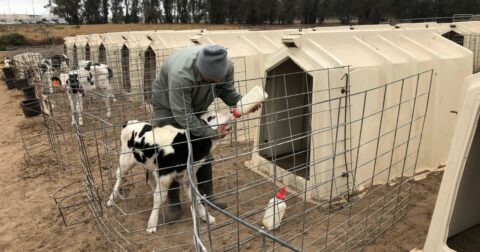Perspective
Critics Declared Veganism Dead in 2025. Here’s What Those Obituaries Are Missing.
Food•5 min read
Feature
A new research project illuminates the connection between prisons and meat processors, and how both benefit from incarcerated labor.


Words by Marlena Williams
The image of a single honey bee crawling up the outstretched arm of a man in a bulky beekeeping suit graces the website of the Washington state Sustainability in Prisons Project. Dozens of other bees buzz about the air around him. In the background, barbed wire prison gates stand stark against gray Washington skies.
The state Department of Corrections runs one of the largest prison sustainability initiatives in the country. The program accepts incarcerated individuals from 11 out of 12 prisons in the state and even offers an option to earn a certificate in beekeeping.
Yet most of the prison labor force in this country isn’t working with expert beekeepers. In fact, you might be surprised to learn just how much of the food on your plate is produced with the help of incarcerated workers. But a new research project aims to change that — The Prison Agriculture Lab is the first ever nationwide study of prison agriculture in the United States.

Exact figures are difficult to determine, but by some estimates roughly 30,000 incarcerated individuals work in farming or food-related jobs — including for mega-producers like Foster Farms and Dairy Farmers of America.
In January, the Lab launched Growing Chains: Prison Agriculture and Racial Capitalism in the United States, where visitors can trace the history of prison agriculture, explore how each state benefits from the practice and learn about the driving factors that keep it alive.
The project’s interactive story map sheds new light on the historic entanglement between animal agriculture and the prison system. One of the most shocking aspects is just how many prisons use incarcerated people — not just to keep bees but to train horses, raise and sell livestock, run dairy operations, staff aquaculture facilities and kill and process poultry.
In the U.S., the prison system has relied on the labor of incarcerated men and women for well over two centuries.
“Agriculture was a pillar of the early prison system because it kept costs down,” says Joshua Sbicca, a sociology professor at Colorado State University and Director of the Prison Agriculture Lab.
Early American prisons like Auburn and Sing Sing in New York were founded on the premise that forced labor had both a cost-saving and a rehabilitative function. Prisoners labored in groups by day and were confined in silence at night. At Bedford Hills Correctional Facility, an early women’s prison in New York, female inmates tended gardens, farmed land and raised animals. Prison officials touted the benefits of this kind of work because it not only kept costs down and prisoners busy but also taught the incarcerated vocational skills.
After the Civil War, Congress passed the 13th Amendment, which abolished slavery — except as punishment for crimes. This paved the way for a vast convict leasing system and the emergence of the Black Codes, in which Black Americans were convicted of harmless, ill-defined crimes such as “vagrancy” and forced back into the same oppressive labor system they thought they had escaped.
Parchman Farm in Mississippi and Louisiana State Penitentiary in Louisiana both sit on the grounds of former plantations that to this day use inmates to pick cotton, grow crops, raise livestock and train the horses used in agricultural field work at the prisons.
As the system expanded through the 20th century, prisons continued to rely on the cheap and often free labor of inmates for all types of work, including farming and animal agriculture. In 1979, Congress passed legislation that paved the way for the creation of the Prison Industry Enhancement Certification Program, a program that exempted state and local prisons from federal restrictions on prisoner-made goods in interstate commerce. This sparked a new proliferation of prison labor operations.
According to the Bureau for Justice Statistics, correctional industry programs in 37 states were partnered with 175 private industries in 2012, bringing in $2 billion in goods and $9 billion in services for these companies, according to the ACLU.
Because incarcerated men and women work for little to no pay and cannot join unions, they form a captive workforce that helps keep costs down. Over a million people are incarcerated in state prisons across the country — and feeding them is an expensive business. Inmates often raise, slaughter, butcher and ultimately cook the animals that are then fed to other prisoners.
Livestock and ranching operations are one of the more profitable segments of the prison agricultural industry, and animal farming can help prison officials make their bottom lines, suggests Sbicca. “It is difficult to make money in agriculture, whether it is behind bars or elsewhere,” he says. “Animals make a little more economic sense.”
The animal agriculture industry’s use of prison labor is widespread and surprisingly varied. At Montana State Prison, incarcerated individuals raise over a thousand cows on 38,000 acres for sale each fall and participate in the Range Program, where they learn the ins-and-outs of breeding, calving, vaccinating and branding. The New Jersey Department of Corrections runs the biggest dairy operation in the state.
At the O.B Ellis Unit in Huntsville, Texas, prisoners manage an egg farm, farrow pigs and even maintain a parakeet aviary. Colorado Correctional Industries is a major producer of buffalo mozzarella — cheese produced by inmates there has made its way to popular chains like Papa John’s, Pizza Hut and Domino’s.
The agribusiness section of Colorado Correctional Industries generates over $6 million dollars a year in profit, though incarcerated workers are paid as little as $0.74 a day. Female inmates at Wyoming Women’s Center work in a state-of-the-art, $2.1 million aquaculture facility raising tilapia for sale across the country. Some of the men incarcerated at Louisiana State Penitentiary — situated on 18,000 sprawling acres of farmland — train the horses that eventually are used by correctional officers.
Many prisons lease inmates out for more violent and inhumane work — like poultry plants, meat processing facilities and slaughterhouses. With anti-immigration policies impacting the number of migrants available to work, agricultural industries have turned to prisons to fill the labor gap, with the added perk that incarcerated workers can’t unionize, quit or be deported. According to a 2017 report from the Heal Food Alliance, contract work for private industry accounts for about 21 percent of agricultural jobs filled by prisoners.
In 2021, Arizona Correctional Industries leased 92 workers to Hickman Family Farms, the largest egg company in the Southwest. According to ACI, Hickman Family Farms had struggled to retain workers willing to labor in what the company describes as admittedly “dirty” conditions. Thanks to this partnership, which generates over $7 million dollars a year in revenue for the state prison system, Hickman now has ample access to “motivated workers that can be relied upon to be at work on time” and who receive no paid vacation or sick leave.
To entice future partnerships, ACI boasts that many incarcerated workers may one day become “post-incarceration men and women ready and skilled to join your company as a civilian on Day 1 of release.”
Yet these workers receive little to no training and face cruel and dangerous conditions. In 2017, Frank Ellington, a man serving a life sentence in Alabama, died while working on the “kill line” at a Koch Farms poultry plant in Ashland. Ellington was just one of more than 1,000 incarcerated people forced to work in similar plants throughout Alabama’s “poultry belt,” generating nearly $11 million a year for the beleaguered Alabama DOC.
An investigation by The Marshall Project uncovered 24 other instances since 2015 in which prisoners were injured, including knife wounds and chemical burns at poultry plants in Georgia and North Carolina.
Jobs in animal agriculture remain some of the most violent, unhealthy and inhumane in the world. Incarcerated workers are forced to not only witness but contribute to the deep suffering of the animals trapped in these conditions. “I think there is an awareness among incarcerated individuals that this kind of work isn’t just harming them,” says Sbicca. “It’s harming the animals too.”
Even the jobs that seem educational, therapeutic or environmentally-friendly on their surface — like the Washington state’s Beekeeping Program — are still part of a coercive system of punishment that harms people and animals alike.
“Exploitation and rehabilitation are both disciplinary,” says Sbicca, who is careful to stress that even jobs that seem arguably rehabilitative and benign still have an inherently exploitative purpose. “By only allowing certain people to participate in these programs, prison officials reproduce the hierarchies within the prison and weaponize someone’s humanity by saying, “‘Well, if you’re good, you’ll get to go outside.’”
While keeping bees, training horses or raising livestock may give incarcerated individuals a rare chance to leave the prison gates and interact with the natural world, these jobs remain an essential part of a system that keeps both people and animals in cages.
Whether on an open range in Montana or a cramped poultry plant in Georgia, the use of prison labor in animal agriculture is a deeply coercive, exploitative and harmful practice. Both systems — prison and animal agriculture — exist largely out of mainstream view, hidden even from the Americans who claim to care about criminal justice or animal rights. Projects like the Prison Agriculture Lab illuminate the interconnectedness of these two systems — allowing us to see that we can work against the abuses inherent to both.
The fights to transform our criminal justice and food systems aren’t disparate battles. People who want to stop this practice can organize to remove the involuntary servitude exception from their state constitutions like voters in Oregon, Alabama, Tennessee and Vermont recently did.
They can also organize campaigns to stop businesses from selling products produced using prison labor, like the activists who convinced Whole Foods to stop selling goat cheese and fish produced by Colorado Correctional Industries. Cutting back on the consumption of animal products and adopting a plant-rich diet also helps curb demand for these products — reducing the prison system’s chance to profit off of them. Acknowledging the deep connection between the prison system and animal agriculture is one more way we can better understand not only what is on our plates but how it got there.